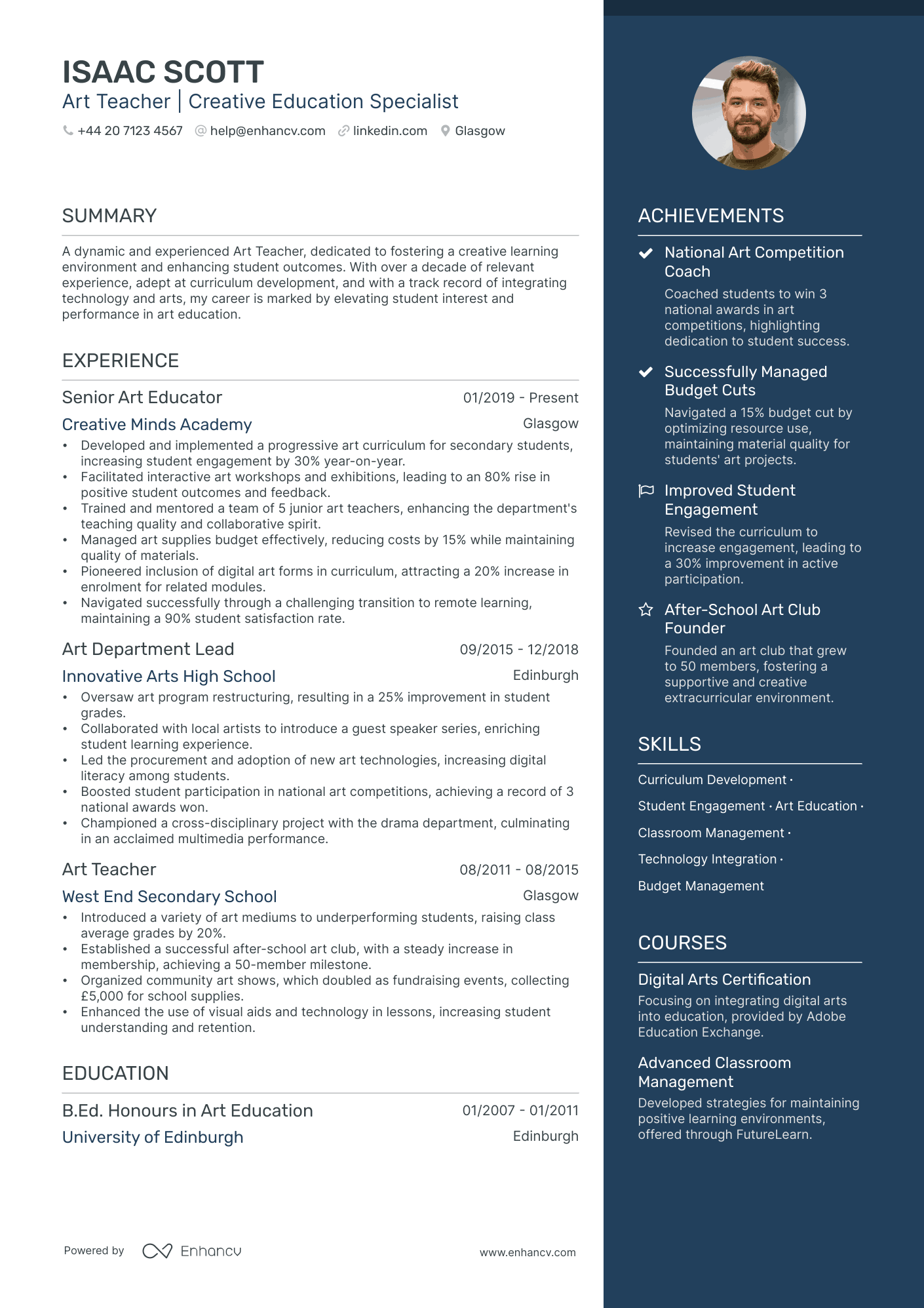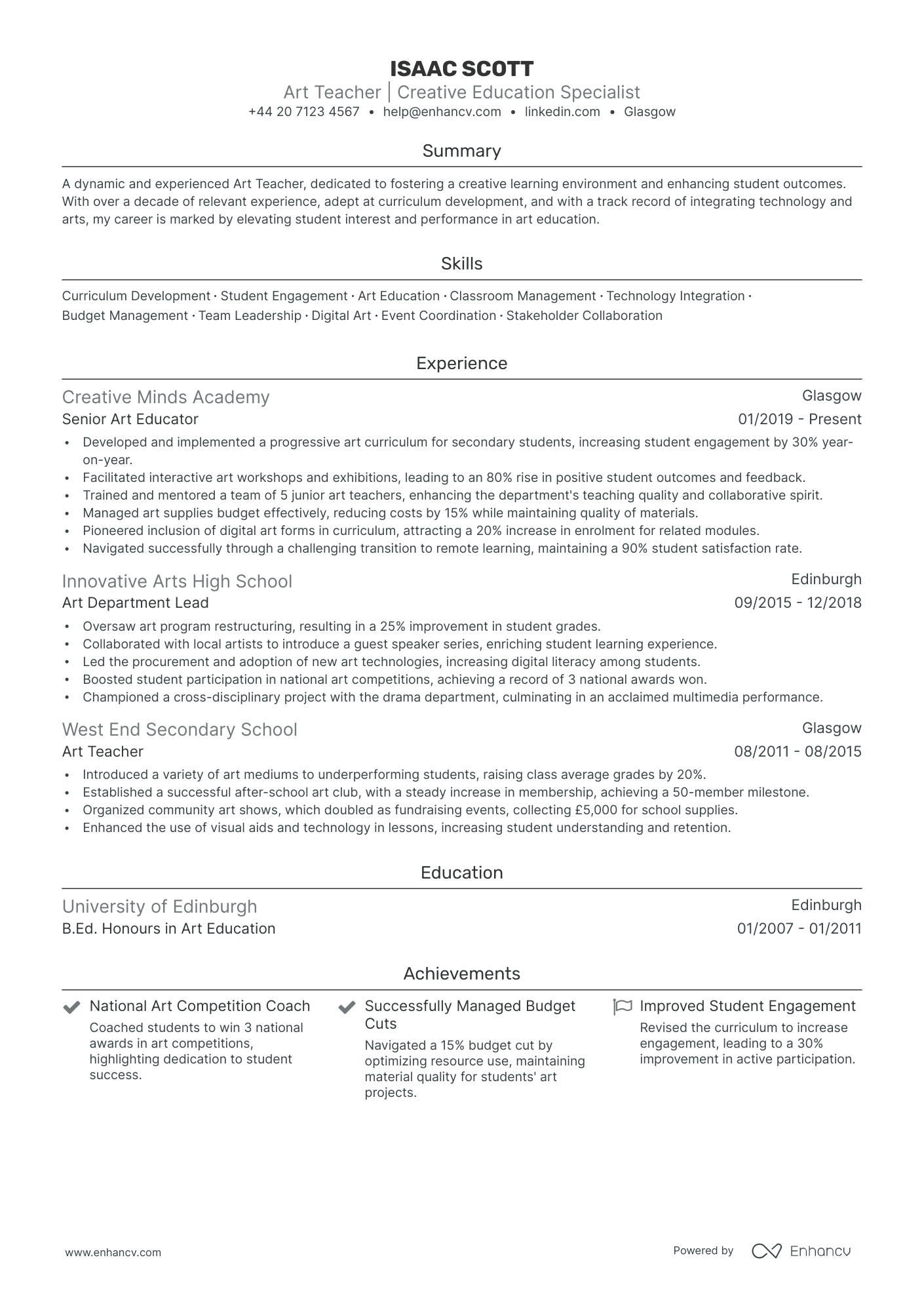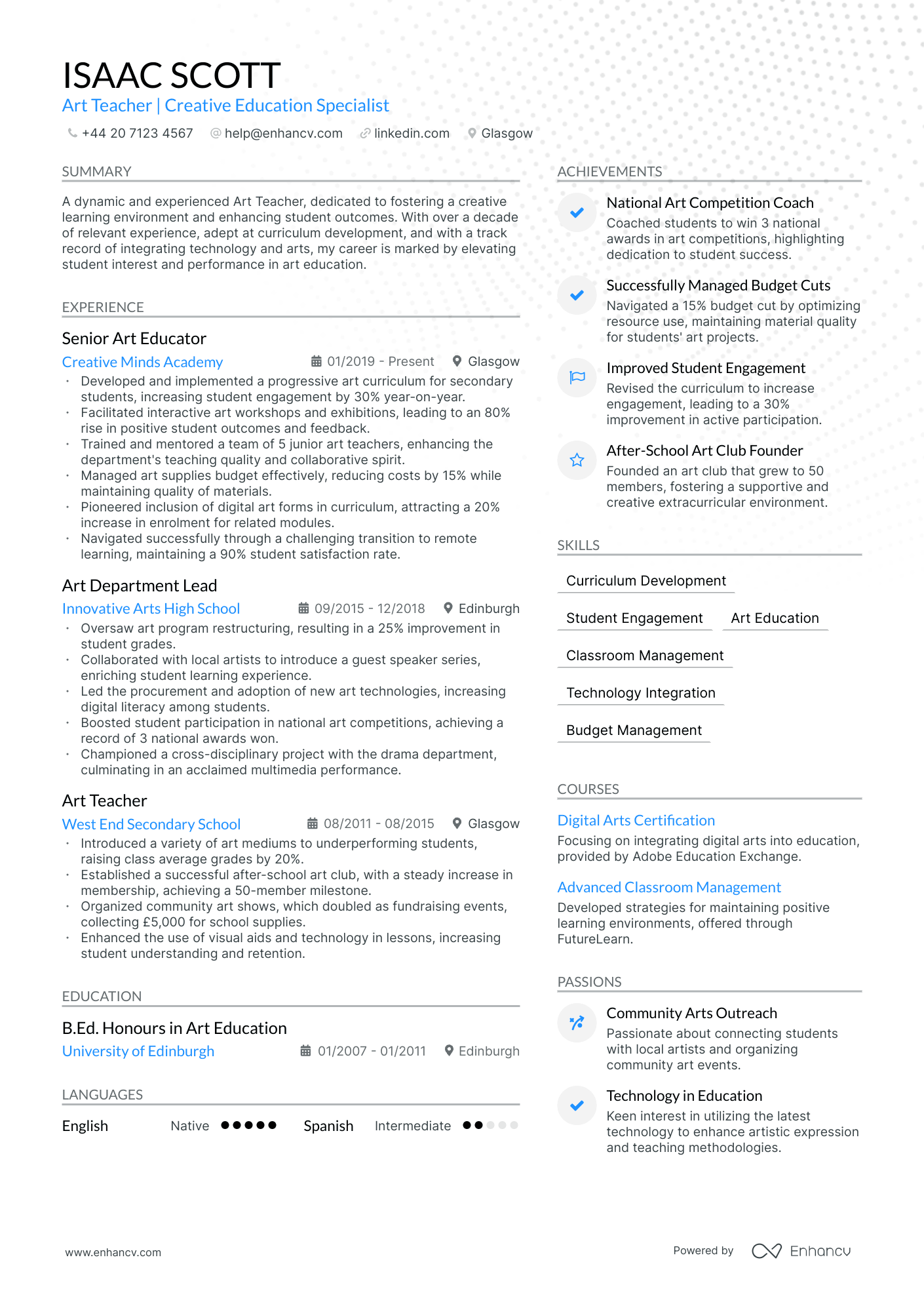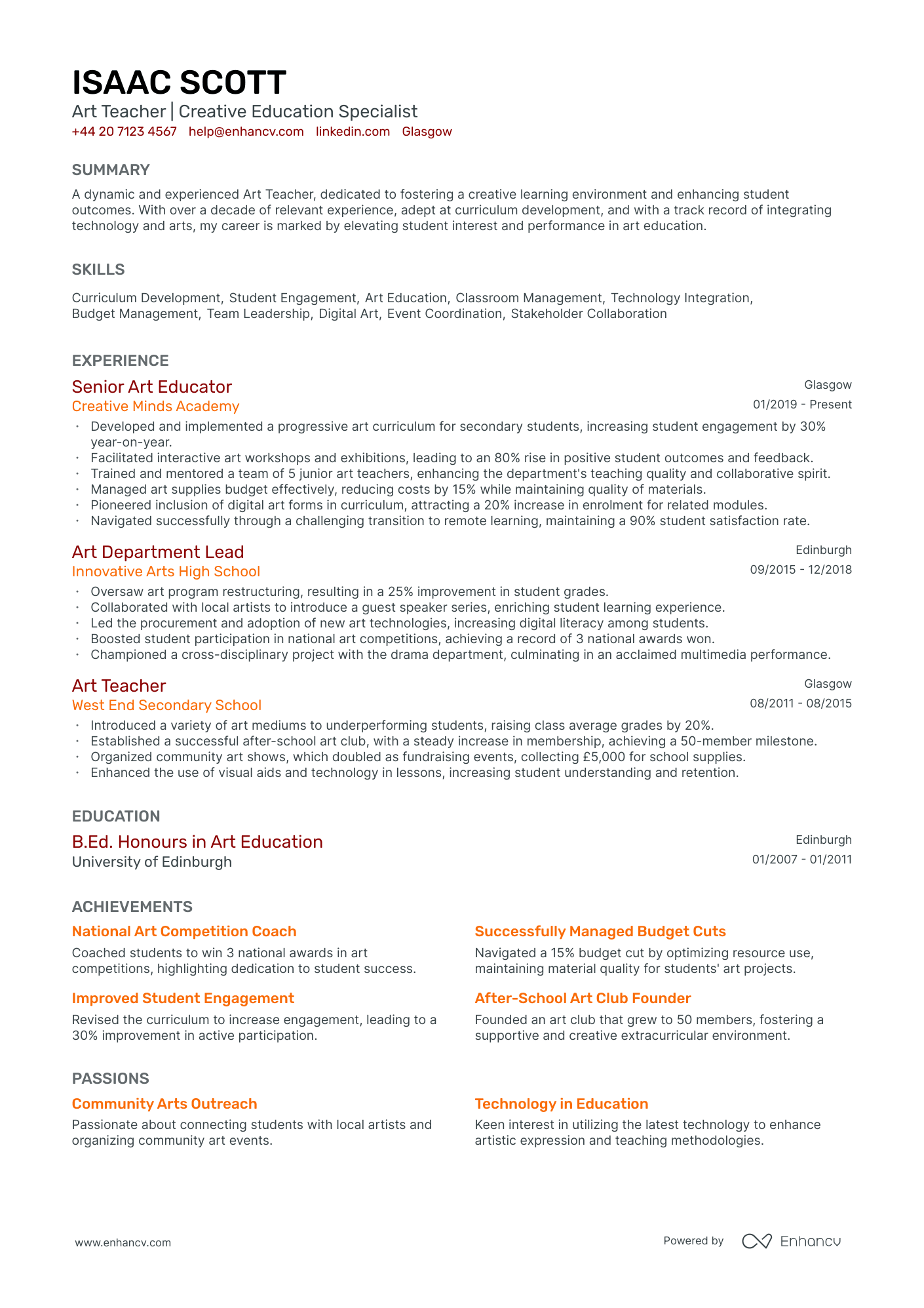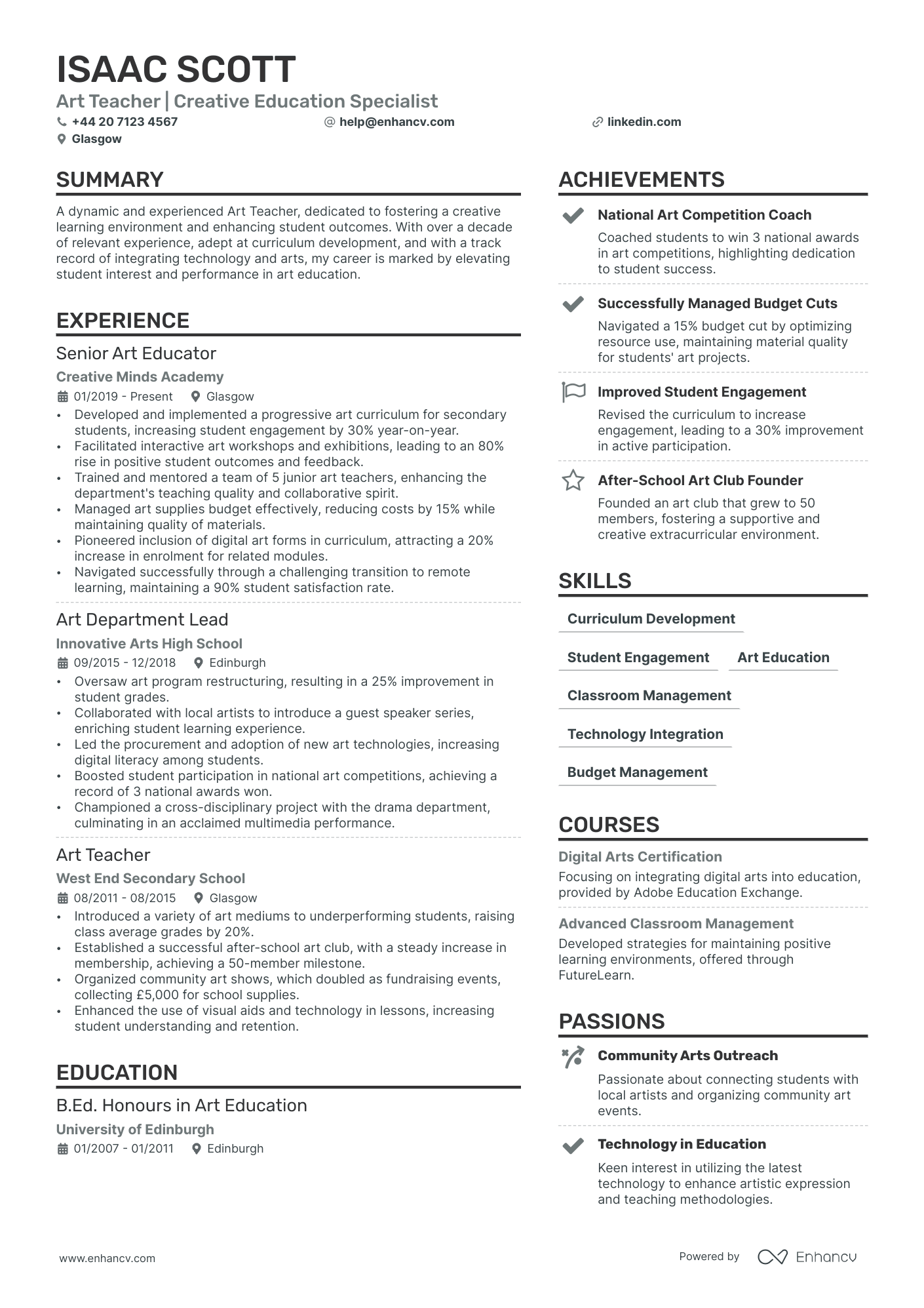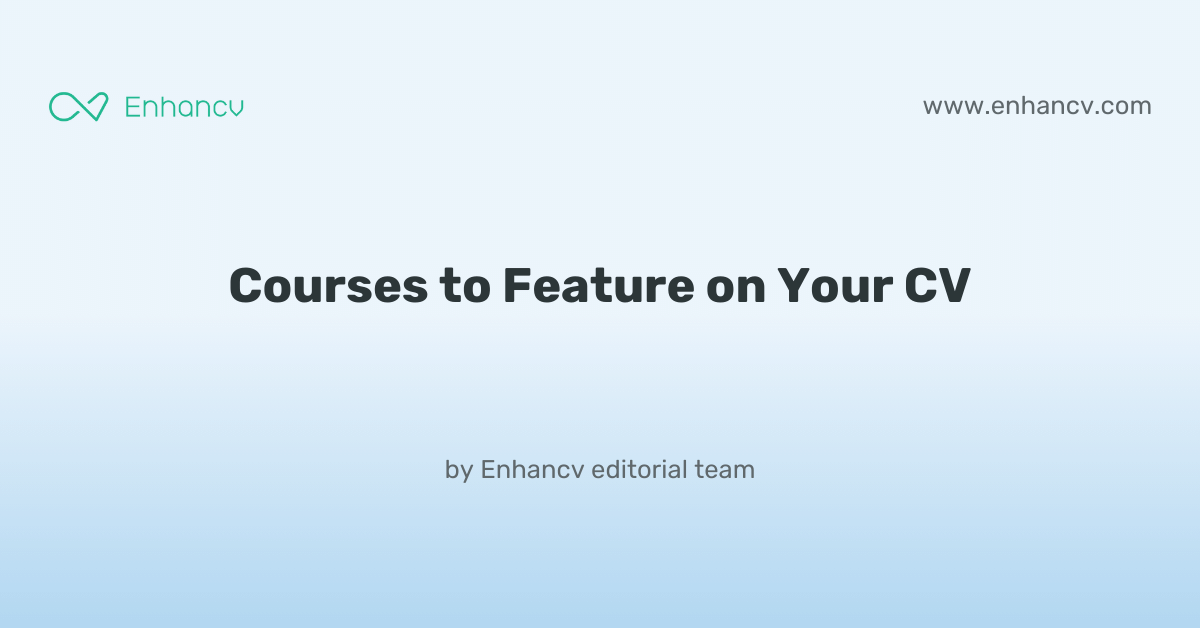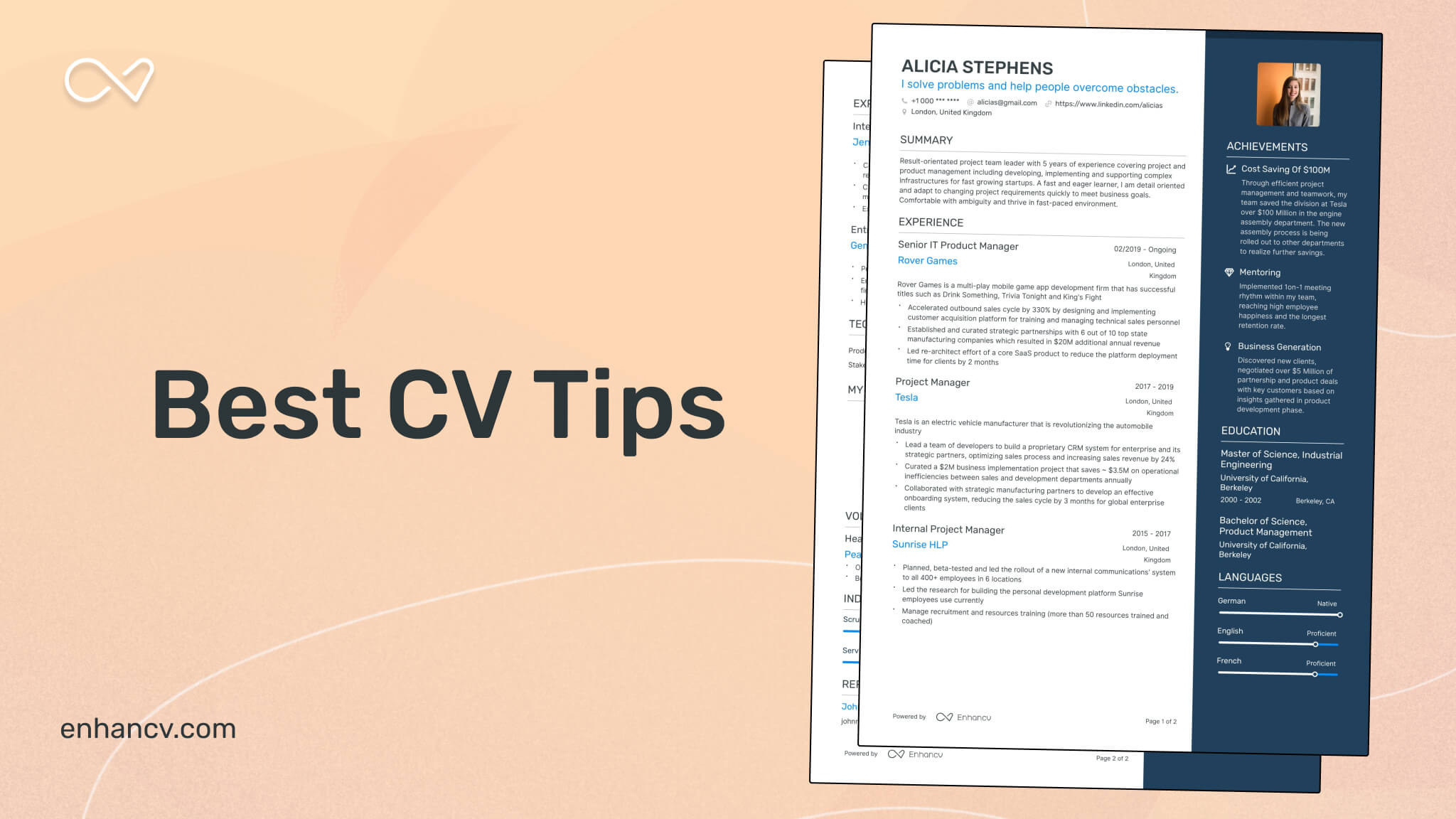Crafting a CV that effectively showcases your diverse range of skills and creative experiences can be daunting for any art teacher. Our comprehensive guide provides you with tailored strategies and examples to highlight your unique artistic abilities and teaching credentials, ensuring your application stands out to potential employers.
- Design and format your professional art teacher CV;
- Curate your key contact information, skills, and achievements throughout your CV sections;
- Ensure your profile stays competitive by studying other industry-leading art teacher CVs;
- Create a great CV even if you happen to have less professional experience, or switching fields.
When writing your art teacher CV, you may need plenty of insights from hiring managers. We have prepared industry-leading advice in the form of our relevant CV guides.
Structuring and formatting your art teacher CV for an excellent first impression
The experts' best advice regarding your CV format is to keep it simple and concise. Recruiters assessing your CV are foremost looking out for candidates who match their ideal job profile. Your white space, borders, and margins. You may still be wondering which format you need to export your CV in. We recommend using the PDF one, as, upon being uploaded, it never alters your information or CV design. Before we move on to the actual content of your art teacher CV, we'd like to remind you about the Applicant Tracker System (or the ATS). The ATS is a software that is sometimes used to initially assess your profile. Here's what you need to keep in mind about the ATS:- All serif and sans-serif fonts (e.g. Rubik, Volkhov, Exo 2 etc.) are ATS-friendly;
- Many candidates invest in Arial and Times New Roman, so avoid these fonts if you want your application to stand out;
- Both single and double column CVs can be read by the ATS, so it's entirely up to you to select your CV design.
PRO TIP
Be mindful of white space; too much can make the CV look sparse, too little can make it look cluttered. Strive for a balance that makes the document easy on the eyes.
The top sections on a art teacher CV
- Personal Statement highlights your passion for teaching and art.
- Teaching Experience showcases your history in education.
- Artistic Achievements reflect your personal engagement in the arts.
- Skill Set emphasises artistic techniques and educational competencies.
- Education and Qualifications show your formal training and certifications.
What recruiters value on your CV:
- Highlight your artistic abilities by including a portfolio link or mentioning specific media you specialise in, as practical skills are crucial for an art teacher to inspire and instruct students effectively.
- Emphasise your understanding of art history and theory, demonstrating your ability to contextualise practical work within a wider art historical framework.
- Detail your experience with art exhibitions or collaborations, which can show your involvement in the art community and your commitment to promoting student engagement with the arts.
- Include any curricular design experience or innovative teaching methods you've employed, to showcase your ability to develop compelling art programmes that cater to a variety of learning styles.
- Describe your classroom management skills and strategies for creating an inclusive and productive learning environment, as fostering a positive atmosphere is key for student creativity and expression.
Recommended reads:
Tips and tricks on writing a job-winning art teacher CV header
The CV header is the space which most recruiters would be referring most often to, in the beginning and end of your application. That is as the CV header includes your contact details, but also a headline and a professional photo. When writing your CV header:
- Double-check your contact details for spelling errors or if you've missed any digits. Also, ensure you've provided your personal details, and not your current work email or telephone number;
- Include your location in the form of the city and country you live in. If you want to be more detailed, you can list your full address to show proximity to your potential work place;
- Don't include your CV photo, if you're applying for roles in the UK or US, as this may bias initial recruiters' assessments;
- Write a professional headline that either integrates the job title, some relevant industry keywords, or your most noteworthy achievement.
In the next part of our guide, we'll provide you with professional CVs that showcase some of the best practices when it comes to writing your headline.
Examples of good CV headlines for art teacher:
- Head of Visual Arts Department | PGCE Certified | Student Engagement | 10+ Years Experience
- Senior Art Educator | MA in Fine Arts | Curriculum Development | Inclusivity Champion | 15 Years Expertise
- Secondary Art Teacher | BA Hons in Art Education | EdTech Innovator | 5 Years in Practice
- Creative Arts Facilitator | Mixed Media Specialist | SEN Experience | NQT Mentor | 8 Years Teaching
- Freelance Arts Tutor | National Diploma in Design | Art History Enthusiast | 3 Years Freelancing
- Lead Art Instructor | PhD in Art Theory | International Collaboration | Advanced Practice | 12 Years Leadership
Catching recruiters' attention with your art teacher CV summary or objective
Located closer to the top of your CV, both the summary and objective are no more than five sentences long and serve as an introduction to your experience. What is more, you could use either to entice recruiters to read on. Select the:
- Summary, if you happen to have plenty of relevant experience. Feature your most impressive accomplishments and up to three skills that are relevant to the job you're applying for;
- Objective, if you're just starting your career off. Provide your career goals and answer how you see the role you are applying for will match your professional growth.
Judging which one you need to add to your art teacher CV may at times seem difficult. That’s why you need to check out how professionals, with similar to your experience, have written their summary or objective, in the examples below:
CV summaries for a art teacher job:
- Experienced Art teacher with over a decade of providing engaging classroom management and fostering a creative environment in secondary education. Proficient in curriculum development with a Master’s degree in Fine Arts and a track record of student exhibitions at local galleries.
- Dedicated Art educator with 7 years of experience teaching in urban high schools, specialising in mixed media and digital art. Developed a successful grant-funded art program and student art shows that increased community engagement and student participation by 35%.
- Career-switcher with a background in graphic design, looking to bring 5 years of professional experience with Adobe Creative Suite and a passion for visual arts to the classroom. Enthusiastic about inspiring a new generation of artists through technology integration and design principles.
- Corporate professional with 6 years of project management and collaborative team leadership, now seeking to transition to art education. Passionate about blending organizational skills with creativity and art history to create a transformative educational atmosphere for students.
- Eager to begin a career in Art teaching, aiming to leverage a fresh perspective and a recent Master’s in Art Education. Driven to apply innovative methods to help students develop their artistic abilities and critical thinking skills.
- Aspiring Art educator with no prior formal teaching experience but armed with a BFA in Sculpture and numerous participations in community art projects. Committed to learning and disseminating knowledge on art techniques and historical contexts to invigorate students' understanding and appreciation of the arts.
Narrating the details of your art teacher CV experience section
Perhaps you've heard it time and time again, but, how you present your experience is what matters the most. Your CV experience section - that details your work history alongside your accomplishments - is the space to spotlight your unqiue expertise and talents. So, avoid solely listing your responsibilities, but instead:
- adverts' keywords and integrate those in your experience section;
- Use your CV to detail how you've been promoted in the past by including experience in the reverse chronological order.
Before you start writing your art teacher CV experience section, dive into some industry-leading examples on how to structure your bullets.
Best practices for your CV's work experience section
- Developed comprehensive art curriculum catering to a diverse student body, including lesson plans that integrated historical art concepts with practical application.
- Fostered a creative classroom atmosphere that encouraged students to express themselves through various mediums such as painting, sculpting, and digital art.
- Assessed student artwork and provided constructive feedback to enhance their technical skills and artistic expression while maintaining a positive learning environment.
- Coordinated with colleagues and senior management to organise annual art shows, showcasing students’ work and promoting the importance of art in education.
- Stayed abreast of current educational strategies and technologies, introducing new art software and digital tools to the curriculum to expand student skill sets.
- Mentored students for regional and national art competitions, resulting in several awards that increased the school's reputation for excellence in the arts.
- Managed the art department budget, ensuring supplies and resources were available and utilised effectively to maximise student learning opportunities.
- Engaged in continuous professional development, attending workshops and training sessions to improve teaching practice and knowledge of contemporary art trends.
- Collaborated with colleagues across disciplines to design interdisciplinary projects that integrated art with subjects like history, literature, and science.
- Structured and delivered comprehensive art curricula for grades 9-12, enhancing students' artistic skills and understanding of art history.
- Pioneered the integration of digital art forms into conventional teaching, which increased student engagement by 40%.
- Spearheaded the annual school art exhibition showcasing over 300 student artworks, significantly raising community involvement and securing local media coverage.
- Coordinated with a team of 5 art teachers to develop a diverse visual arts program that emphasized multicultural art forms and techniques.
- Led a classroom of 25 students in mastering complex concepts in art theory and practice, resulting in a 50% improvement in advanced placement test scores.
- Organized and managed a successful crowdfunding campaign for art supplies, raising $5,000 and enabling the expansion of the classroom resources.
- Implemented an experimental art program focused on interactivity and new media, attracting a 30% increase in student enrollments for elective art classes.
- Collaborated with local artists to facilitate workshops, introducing students to real-world art practices and expanding community partnerships.
- Evaluated and revised the grade 6-8 visual arts curriculum, improving alignment with state standards and enhancing student preparatory outcomes for high school art education.
- Developed a cross-curricular art program linking visual arts to subjects such as history and science, fostering interdisciplinary understanding and student appreciation.
- Designed and implemented a differentiated instruction plan that catered to the diverse learning needs and skills of 150+ students.
- Launched a school-wide recycling project through art, teaching students about environmental sustainability while creating art from repurposed materials.
- Organized a series of successful student participation in city-wide art contests, resulting in numerous awards and recognitions for the school’s art program.
- Cultivated a digital art and photography option for students, heavily incorporating technology into their art making process.
- Facilitated after-school art programs for students with special needs, improving their motor skills and self-expression through tailored artistic activities.
- Developed individualized learning plans that contributed to a 60% increase in students’ technical proficiency in various art mediums.
- Created and led professional development workshops for art teachers on integrating technology in the arts, which was adopted by the entire district.
- Coordinated with a team to secure a $10,000 grant for the art department, expanding program resources and student opportunities for artistic expression.
- Revamped the art curriculum to include 21st-century skills and learning strategies, enhancing creativity and innovation in student projects.
- Mentored and supervised a group of student art assistants, guiding their development in leadership and teaching skills within the art studio environment.
- Initiated a partnership with a local museum to create a student docent program, increasing student involvement in the arts community.
- Oversaw the development of an online art education platform, allowing for virtual learning and reaching an additional 100 remote students.
- Implemented a student-led portfolio review process, whereby students assessed their own and their peers' art, fostering a collaborative learning environment.
- Engaged in continuous curriculum optimization based on student performance data, leading to a 35% increase in art class retention rates.
- Authored a successful proposal for a public art project involving students, securing a $15,000 grant from the city council.
- Curated a large-scale art installation involving over 200 students, promoting inclusivity and teamwork within the school environment.
- Implemented a classroom management strategy that decreased behavioral incidents by 45%, creating a more conducive learning atmosphere for art education.
- Introduced a virtual reality art program, expanding the school’s curriculum and offering students exposure to cutting-edge artistic technology.
- Drove participation in national art competitions, resulting in 5 students receiving scholarships for their exceptional work.
- Co-developed a school-wide intercultural art project, promoting diversity and intercultural understanding through collaborative workshops and exhibitions.
Writing your CV without professional experience for your first job or when switching industries
There comes a day, when applying for a job, you happen to have no relevant experience, whatsoever. Yet, you're keen on putting your name in the hat. What should you do? Candidates who part-time experience , internships, and volunteer work.
Recommended reads:
PRO TIP
Include examples of how you adapted to new tools, environments, or work cultures, showing your flexibility.
Mix and match hard and soft skills across your art teacher CV
Your skill set play an equally valid role as your experience to your application. That is because recruiters are looking for both:
- hard skills or your aptitude in applying particular technologies
- soft skills or your ability to work in a team using your personal skills, e.g. leadership, time management, etc.
Are you wondering how you should include both hard and soft skills across your art teacher CV? Use the:
- skills section to list between ten and twelve technologies that are part of the job requirement (and that you're capable to use);
- strengths and achievements section to detail how you've used particular hard and soft skills that led to great results for you at work;
- summary or objective to spotlight up to three skills that are crucial for the role and how they've helped you optimise your work processes.
One final note - when writing about the skills you have, make sure to match them exactly as they are written in the job ad. Take this precautionary measure to ensure your CV passes the Applicant Tracker System (ATS) assessment.
Top skills for your art teacher CV:
Artistic Ability
Knowledge of Art History
Drawing and Painting Techniques
Familiarity with Digital Art tools
Classroom Management
Lesson Planning
Curriculum Design
Assessment and Evaluation
Material and Equipment Use
Special Needs Education Techniques
Creativity
Communication
Patience
Interpersonal Skills
Adaptability
Time Management
Organizational Skills
Enthusiasm
Critical Thinking
Motivational Skills
PRO TIP
Use mini case studies or success stories in your CV to demonstrate how your skills have positively impacted previous roles or projects.
CV education and certificates: your academic background as proof of your skill set
A common misconception about your art teacher CV education is that you only need it, if you have less professional experience. That is completely false. The CV education section serves to back up your technical (and sometimes personal) capabilities, fill in gaps in your work history, and show you have the initial industry background and know-how. When creating your education section:
- List your degrees in the reverse chronological order, starting with the most recent (and relevant) ones first;
- Include your degree and university names, start and graduation dates. It's optional to also denote you received a "First-Class Honours" for diplomas that are more relevant to the role;
- Curate your relevant university coursework, projects, or thesis work if you happen to have less professional expertise and need to integrate more job keywords and skills.
Your professional qualifications don't need to stop at your academic background. It's advisable to also select up to three of your most noteworthy (and relevant) industry certificates and feature them in a dedicated section. Once more, include the certificate name, the institution that issued it out, and the date you obtained it on. You could feature both hard skills and soft skills certificates, as in the examples below:
PRO TIP
Use mini case studies or success stories in your CV to demonstrate how your skills have positively impacted previous roles or projects.
Recommended reads:
Key takeaways
Here are five things you need to remember about writing your art teacher CV for success:
- Sort your experience based on the reverse chronological order, starting with your most recent career items, to showcase how you've grown your career;
- Include within your CV header your relevant contact details, a headline that could spotlight your unique value, and a photo - if you're applying for roles outside the UK or US;
- Decide to use the CV summary, if you happen to have more professional experience, and an objective, if you want to showcase your career goals;
- Within the experience section, write your bullets using action verbs, skills, and success, instead of just merely listing your on-the-job responsibilities;
- Prove your technical skills, using your education and certificates, and your soft skills, with your achievements and strengths sections.
